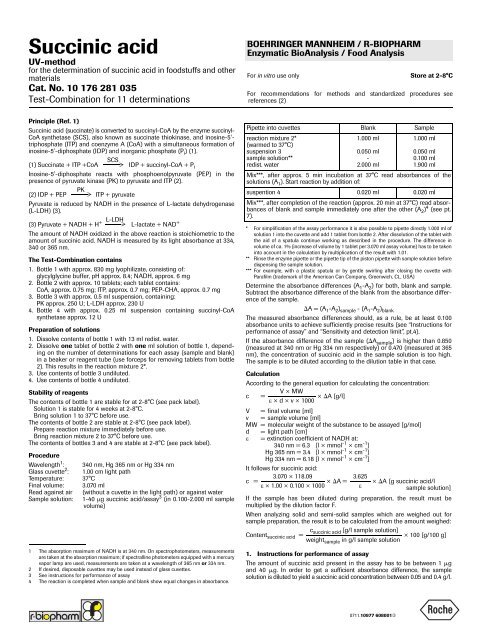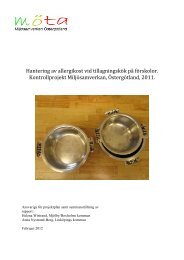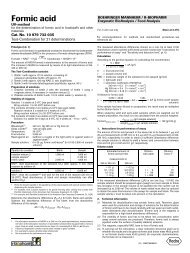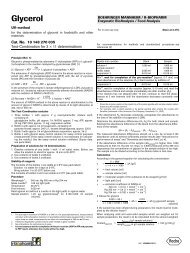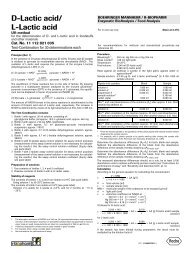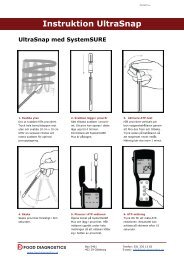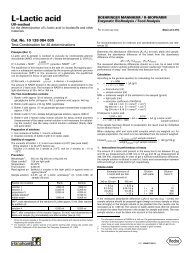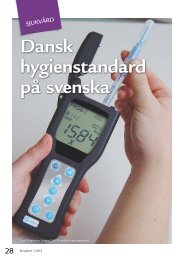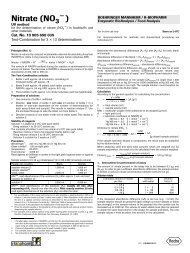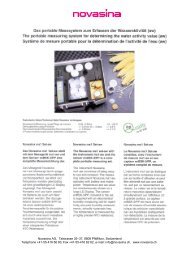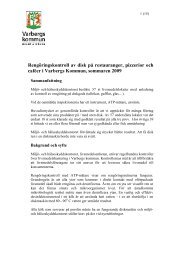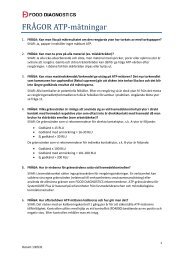Succinic acid - Food Diagnostics AB
Succinic acid - Food Diagnostics AB
Succinic acid - Food Diagnostics AB
Create successful ePaper yourself
Turn your PDF publications into a flip-book with our unique Google optimized e-Paper software.
<strong>Succinic</strong> <strong>acid</strong>UV-methodfor the determination of succinic <strong>acid</strong> in foodstuffs and othermaterialsCat. No. 10 176 281 035Test-Combination for 11 determinationsBOEHRINGER MANNHEIM / R-BIOPHARMEnzymatic BioAnalysis / <strong>Food</strong> AnalysisFor in vitro use onlyStore at 2-8°CFor recommendations for methods and standardized procedures seereferences (2)Principle (Ref. 1)<strong>Succinic</strong> <strong>acid</strong> (succinate) is converted to succinyl-CoA by the enzyme succinyl-CoA synthetase (SCS), also known as succinate thiokinase, and inosine-5'-triphosphate (ITP) and coenzyme A (CoA) with a simultaneous formation ofinosine-5'-diphosphate (IDP) and inorganic phosphate (P i ) (1).SCS(1) Succinate + ITP +CoA IDP + succinyl-CoA + P iInosine-5'-diphosphate reacts with phosphoenolpyruvate (PEP) in thepresence of pyruvate kinase (PK) to pyruvate and ITP (2).PK(2) IDP + PEP ITP + pyruvatePyruvate is reduced by NADH in the presence of L-lactate dehydrogenase(L-LDH) (3).Pipette into cuvettes Blank Samplereaction mixture 2*(warmed to 37°C)suspension 3sample solution**redist. water1.000 ml0.050 ml-2.000 ml1.000 ml0.050 ml0.100 ml1.900 mlMix***, after approx. 5 min incubation at 37°C read absorbances of thesolutions (A 1 ). Start reaction by addition of:suspention 4 0.020 ml 0.020 mlMix***, after completion of the reaction (approx. 20 min at 37°C) read absorbancesof blank and sample immediately one after the other (A 2 ) 4 (see pt.7).(3) Pyruvate + NADH + H + L-LDH L-lactate + NAD + * For simplification of the assay performance it is also possible to pipette directly 1.000 ml ofThe amount of NADH oxidized in the above reaction is stoichiometric to the solution 1 into the cuvette and add 1 tablet from bottle 2. After dissolution of the tablet withamount of succinic <strong>acid</strong>. NADH is measured by its light absorbance at 334,340 or 365 nm.the aid of a spatula continue working as described in the procedure. The difference involume of ca. 1% (increase of volume by 1 tablet per 3.070 ml assay volume) has to be takeninto account in the calculation by multiplication of the result with 1.01.The Test-Combination contains** Rinse the enzyme pipette or the pipette tip of the piston pipette with sample solution beforedispensing the sample solution.1. Bottle 1 with approx. 830 mg lyophilizate, consisting of:*** For example, with a plastic spatula or by gentle swirling after closing the cuvette withglycylglycine buffer, pH approx. 8.4; NADH, approx. 6 mgParafilm (trademark of the American Can Company, Greenwich, Ct., USA)2. Bottle 2 with approx. 10 tablets; each tablet contains:Determine the absorbance differences (ACoA, approx. 0.75 mg; ITP, approx. 0.7 mg; PEP-CHA, approx. 0.7 mg1 -A 2 ) for both, blank and sample.Subtract the absorbance difference of the blank from the absorbance differenceof the sample.3. Bottle 3 with approx. 0.5 ml suspension, containing:PK approx. 250 U; L-LDH approx. 230 U4. Bottle 4 with approx. 0.25 ml suspension containing succinyl-CoAA = (A 1 -A 2 ) sample - (A 1 -A 2 ) blanksynthetase approx. 12 UPreparation of solutionsThe measured absorbance differences should, as a rule, be at least 0.100absorbance units to achieve sufficiently precise results (see “Instructions forperformance of assay” and “Sensitivity and detection limit”, pt.4).1. Dissolve contents of bottle 1 with 13 ml redist. water.If the absorbance difference of the sample (A sample ) is higher than 0.8502. Dissolve one tablet of bottle 2 with one ml solution of bottle 1, dependingon the number of determinations for each assay (sample and blank) nm), the concentration of succinic <strong>acid</strong> in the sample solution is too high.(measured at 340 nm or Hg 334 nm respectively) or 0.470 (measured at 365in a beaker or reagent tube (use forceps for removing tablets from bottle The sample is to be diluted according to the dilution table in that case.2). This results in the reaction mixture 2*.3. Use contents of bottle 3 undiluted.4. Use contents of bottle 4 undiluted.CalculationAccording to the general equation for calculating the concentration:Stability of reagentsV × MWc =× A [g/l]The contents of bottle 1 are stable for at 2-8°C (see pack label). × d × v × 1000Solution 1 is stable for 4 weeks at 2-8°C.V = final volume [ml]Bring solution 1 to 37°C before use.v = sample volume [ml]The contents of bottle 2 are stable at 2-8°C (see pack label).MW = molecular weight of the substance to be assayed [g/mol]Prepare reaction mixture immediately before use.d = light path [cm]Bring reaction mixture 2 to 37°C before use. = extinction coefficient of NADH at:The contents of bottles 3 and 4 are stable at 2-8°C (see pack label).340 nm = 6.3 [l × mmol -1 × cm -1 ]Hg 365 nm = 3.4 [l × mmolProcedure× cm -1 ]Wavelength 1 Hg 334 nm = 6.18 [l × mmol -1 × cm -1 ]: 340 nm, Hg 365 nm or Hg 334 nmGlass cuvette 2 It follows for succinic <strong>acid</strong>:: 1.00 cm light pathTemperature: 37°C3.070 × 118.09c =× A = 3.625 × A [g succinic <strong>acid</strong>/lFinal volume: 3.070 ml × 1.00 × 0.100 × 1000sample solution]Read against airSample solution:(without a cuvette in the light path) or against water1-40 g succinic <strong>acid</strong>/assay 3 (in 0.100-2.000 ml samplevolume)1 The absorption maximum of NADH is at 340 nm. On spectrophotometers, measurementsare taken at the absorption maximum; if spectralline photometers equipped with a mercuryvapor lamp are used, measurements are taken at a wavelength of 365 nm or 334 nm.2 If desired, disposable cuvettes may be used instead of glass cuvettes.3 See instructions for performance of assay4 The reaction is completed when sample and blank show equal changes in absorbance.If the sample has been diluted during preparation, the result must bemultiplied by the dilution factor F.When analyzing solid and semi-solid samples which are weighed out forsample preparation, the result is to be calculated from the amount weighed:c succinic <strong>acid</strong> [g/l sample solution]Content succinic <strong>acid</strong> =× 100 [g/100 g]weight sample in g/l sample solution1. Instructions for performance of assayThe amount of succinic <strong>acid</strong> present in the assay has to be between 1 gand 40 g. In order to get a sufficient absorbance difference, the samplesolution is diluted to yield a succinic <strong>acid</strong> concentration between 0.05 and 0.4 g/l.0711.10977 608001➂
Dilution tableEstimated amount ofsuccinic <strong>acid</strong> per liter 0.4 g0.4-4.0 g4.0-40 g> 40 gDilutionwith water-1 + 91 + 991 + 999Dilutionfactor F1101001000If the measured absorbance difference (A) is too low (e.g. 0.100), thesample solution should be prepared again (weigh out more sample or diluteless strongly) or the sample volume to be pipetted into the cuvette can beincreased up to 2.000 ml. The volume of water added must then be reducedto obtain the same final volume in the assays for sample and blank. The newsample volume v must be taken into account in the calculation.2. Technical information2.1 Sample preparation with concentrated Carrez-solutions hasproved beneficial in the analysis of liquid whole egg and wholeegg powder (see ref. 2.1). The sample solution can also be usedfor the determination of D-3-hydroxybutyric <strong>acid</strong> and L-lactic<strong>acid</strong>.2.2 In carrying out the calculation, a clear indication should be given as towhether the results are to be given as succinic <strong>acid</strong> (molar mass 118.09g/mol) or as succinate (molar mass 116.07g/mol). (In enzymatic determinations,the succinate ion is measured.)3. Specificity (Ref. 1)Succinyl-CoA synthetase reacts not only with succinic <strong>acid</strong> but also withitaconic <strong>acid</strong>. In comparison to succinic <strong>acid</strong> the content of itaconic <strong>acid</strong> infoodstuffs is very low. Therefore, this fact is unimportant for the determinationof succinic <strong>acid</strong>.In the analysis of commercial succinic <strong>acid</strong>, results of approx. 100 % have toexpected.4. Sensitivity and detection limit (Ref. 1.2)The smallest differentiating absorbance for the procedure is 0.005absorbance units. This corresponds to a maximum sample volume v =2.000 ml and measurement at 340 of a succinic concentration of 0.15 mg/lsample solution (if v = 0.100 ml, this corresponds to 3mg/l sample solution).The detection limit of 0.6 mg/l is derived from the absorbance difference of0.020 (as measured at 340 nm) and a maximum sample volume v = 2.000 ml.5. LinearityLinearity of the determination exists from approx. 1 g succinic <strong>acid</strong>/assay(0.6 mg succinic <strong>acid</strong>/l sample solution; sample volume v = 2.000 ml) to 40 gsuccinic <strong>acid</strong>/assay (0.4 g succinic <strong>acid</strong>/l sample solution; sample volumev = 0.100 ml).6. PrecisionIn a double determination using one sample solution, a difference of 0.005 to0.010 absorbance units may occur. With a sample volume of v = 0.100 mland measurement at 340 nm, this corresponds to a succinic <strong>acid</strong> concentrationof approx. 3-6 mg/l. (If the sample is diluted during sample preparation, theresult has to be multiplied by the dilution factor F. If the sample is weighed infor sample preparation, e.g. using 1 g sample/100 ml = 10 g/l, a difference of0.03-0.06 g/100 g can be expected.)The following data have been published in the literature:CV = 0.98-1.4 % n = 15 in series (Ref. 1.2)Whole egg powder:x = 11 mg/kg r = 06.8 mg/kg s (r) = ± 2.4 mg/kgR = 12.1 mg/kg s (R) = ± 4.3 mg/kg (Ref. 2.1)7. Interference/sources of errorFumaric <strong>acid</strong> reacts with SCS, although very slowly with a creep reactionunder the aforementioned conditions. This can be eliminated by mathematicalextrapolation as usual.The presence of “NADH oxidases” in the assay system as well as thetendency of succinyl-CoA for hydrolysis (especially under alkaline conditions)leads to creep reactions. If the absorbance of blank and sample is readimmediately one after the other, extrapolation of the absorbance values backto the time of the addition of suspension 4 (SCS) is not necessary.8. Recognizing interference during the assay procedure8.1 If the conversion of succinic <strong>acid</strong> has been completed according to thetime given under “Procedure“, it can be concluded in general that nointerference has occurred.8.2 On completion of the reaction, the determination can be restarted byadding succinic <strong>acid</strong> (qualitative or quantitative): if the absorbance isaltered subsequent to the addition of the standard material, this is alsoan indication that no interference has occurred.8.3 Operator error or interference of the determination through thepresence of substances contained in the sample can be recognized bycarrying out a double determination using two different samplevolumes (e.g. 0.100 ml and 0.200 ml): the measured differences inabsorbance should be proportional to the sample volumes used.When analyzing solid samples, it is recommended that differentquantities (e.g. 1 g and 2 g) be weighed into 100 ml volumetric flasks.The absorbance differences measured and the weights of sample usedshould be proportional for identical sample volumes.8.4 Possible interference caused by substances contained in the samplecan be recognized by using an internal standard as a control: in additionto the sample, blank and standard determinations, a further determinationshould be carried out with sample and assay control solution in thesame assay. The recovery can then be calculated from the absorbancedifferences measured.8.5 Possible losses during the determination can be recognized by carryingout recovery tests: the sample should be prepared and analyzed withand without added standard material. The additive should be recoveredquantitatively within the error range of the method.9. Reagent hazardThe reagents used in the determination of succinic <strong>acid</strong> are not hazardousmaterials in the sense of the Hazardous Substances Regulations, theChemicals Law or EC Regulation 67/548/EEC and subsequent alteration,supplementation and adaptation guidelines. However, the general safetymeasures that apply to all chemical substances should be adhered to.After use, the reagents can be disposed of with laboratory waste, but localregulations must always be observed. Packaging material can be disposedof in waste destined for recycling.10. General information on sample preparationIn carrying out the assay:Use clear, colorless and practically neutral liquid samples directly, orafter dilution according to the dilution table, and of a volume up to 2.000 ml;Filter turbid solutions;Degas samples containing carbon dioxide (e.g. by filtration);Adjust <strong>acid</strong> samples to pH 8-9 by adding sodium or potassium hydroxidesolution;Adjust <strong>acid</strong> and weakly colored samples to pH 8-9 by adding sodium orpotassium hydroxide solution and incubate for approx. 15 min;Treat “strongly colored” samples that are used undiluted or with a highersample volume with polyvinylpolypyrrolidone (PVPP) - (e.g. 1 g/100 ml);Crush or homogenize solid or semi-solid samples, extract with water ordissolve in water and filter if necessary; resp. remove turbidities or dyestuffsby Carrez clarification;Deproteinize samples containing protein with perchloric <strong>acid</strong>, alternativelyclarify with Carrez reagent;Extract samples containing fat with hot water (extraction temperatureshould be above the melting point of the fat involved). Cool to allow the fatto separate, make up to the mark, place the volumetric flask in an ice bathfor 15 min and filter; alternatively clarify with Carrez-solutions after theextraction with hot water.Carrez clarification:Pipette the liquid sample into a 100 ml volumetric flask which containsapprox. 60 ml redist. water, or weigh sufficient quantity of the sample into a100 ml volumetric flask and add approx. 60 ml redist. water. Subsequently,carefully add 5 ml Carrez-I-solution (potassium hexacyanoferrate(II) (ferrocyanide),85 mM = 3.60 g K 4 [Fe(CN) 6 ] × 3 H 2 O/100 ml) and 5 ml Carrez-IIsolution(zinc sulfate, 250 mM = 7.20 g ZnSO 4 × 7 H 2 O/100 ml). Adjust to pH7.5-8.5 with sodium hydroxide (0.1 M; e.g. 10 ml). Mix after each addition. Fillthe volumetric flask to the mark, mix and filter.Preparation of egg and egg product samples is dealt with in pt. 11 (applicationexamples). Note: Treatment with concentrated Carrez-solutions has provedbeneficial in routine analysis. In Germany, the method has been standardizedand published in § 35 of the <strong>Food</strong>stuffs and Consumer Goods Law(Lebensmittel- and Bedarfsgegenständegesetz, LMBG). The sample solutionresulting from Carrez clarification can also be used for the determination ofD-3-hydroxybutyric <strong>acid</strong> and of L-lactic <strong>acid</strong>.11. Application examplesDetermination of succinic <strong>acid</strong> in wine<strong>Succinic</strong> <strong>acid</strong> can be determined in white or red wine normally withoutprevious dilution or decolorization. Use 0.100 ml of the sample for the assay.Determination of succinic <strong>acid</strong> in soy sauceAdd 2 ml diluted Carrez-I-solution (3.60 g potassium hexacyanoferrate(II),K 4 [Fe(CN) 6 ] × 3 H 2 O/100 ml) to 1 ml soy sauce and swirl gently. After addi-2
tion of 2 ml diluted Carrez-II-solution (7.20 g zinc sulfate, ZnSO 4 × 7 H 2 O/100 ml) swirl gently and filter (do not neutralize, otherwise the solutionbecomes black again!). Use v = 0.100 ml of the filtrate for the assay. Dilutionfactor F = 5 is to be taken into account in the calculation.Determination of succinic <strong>acid</strong> in fruit juicesUse colorless fruit juices directly for the assay. Because of the low content ofsuccinic <strong>acid</strong> the sample volume is mostly larger than 0.100 ml. Acidic juiceshave to be neutralized (the dilution by addition of alkali must be taken intoaccount). Colored juices have to be treated with PVPP according to theabove mentioned procedure.Determination of succinic <strong>acid</strong> in protein-containing samplesAdd to protein-containing sample solutions perchloric <strong>acid</strong> (1 M) in a ratioof 1+2 to 1+3, mix and centrifuge. Neutralize an aliquot volume of the supernatantsolution with KOH (2 M), dilute to a certain volume in the volumetricflask, place in a refrigerator for 20 min in order to precipitate the KCIO 4 andfilter. Use the clear solution, which may be diluted, if necessary, for the assay.Determination of succinic <strong>acid</strong> in Swiss cheeseAccurately weigh approx. 5 g of ground cheese into a 100 ml volumetricflask, add about 80 ml redist. water and incubate at 60°C for 15 min. Shakeflask from time to time. After cooling to 20-25°C, fill up to the mark withwater. For separation of fat, place in a refrigerator for approx. 20 min andcentrifuge. Use 0.100 to 0.200 ml for the assay.Determination of succinic <strong>acid</strong> in liquid whole egg (Ref. 2.1)Accurately weigh approx. 5 g homogenized whole egg into a 25 ml-volumetricflask, add 10 ml redist. water, one drop n-octanol, mix and heat for 15 min ina water-bath (approx. 100°C). Allow to cool to 20-25°C, and add one after theother and shake after each addition: 1 ml concentrated Carrez-I-solution(15.0 g potassium hexacyanoferrate(II), K 4 [Fe(CN) 6 ] × 3 H 2 O/100 ml), 1 mlconcentrated Carrez-II-solution (30.0 g zinc sulfate, ZnSO 4 × 7 H 2 O/100 ml). Fillup to the mark with NaOH (0.1 M), mix and filter with a fluted filter paper in aglass funnel. Use filtrate for the assay (v = 0.100 ml, when using microbial contaminatedegg; v = 1.000 ml, when using fresh egg). The altered sample volumemust be taken into account in the calculation.Determination of succinic <strong>acid</strong> in whole egg powder (Ref. 2.1)Accurately weigh approx. 1 g whole egg powder into 25 ml volumetric flask,add 12 ml redist water and one drop n-octanol, mix and heat for 15 min in awater-bath (approx. 100°C). Allow to cool to 20-25°C, add one after the otherand shake rigorously after each addition: 1 ml concentrated Carrez-I-solution(15.0 g potassium hexacyanoferrate(II), K 4 [Fe(CN) 6 ] × 3 H 2 O/100 ml), 1 mlconcentrated Carrez-II-solution (30.0 g zinc sulfate, ZnSO 4 × 7 H 2 O/100 ml).Adjust to pH 8-9 with NaOH (1 M), fill up to the mark with redist. water, mixand filter with a fluted filter paper in a glass funnel. Use 0.100-1.000 ml filtratefor the assay. The altered sample volume must be taken into account in thecalculation.Determination of succinic <strong>acid</strong> in pastes containing soy bean flourWeigh approx. 5 g pasty material (accuracy 1 mg) into a 50 ml-volumetric flaskand add 40 ml redist. water. Heat for 10 min in a water-bath (approx. 70°C).Allow to cool to 20-25°C and fill up to the mark with redist. water. Mix and filter.Discard the first few ml of the filtrate. Use 0.100 ml of the filtrate for the assay.12. Further applicationsThe method may also be used in research for the analysis of biological materials.For details of sampling, treatment and stability of the sample see Ref. 1.2.References1.1 Michal, G., Beutler, H.-O., Lang, G. & Güntner, U. (1976) Enzymatic determination ofsuccinic <strong>acid</strong> in foodstuffs, Z. Anal. Chem. 279, 137-1381.2 Beutler, H.-O. (1985) in Methods of Enzymatic Analysis (Bergmeyer, H. U., ed.) 3rd ed.,vol. VII, pp. 25-33, Verlag Chemie Weinheim, Deerfield Beach/Florida, Basel2.1 Amtliche Sammlung von Untersuchungsverfahren nach § 35 LMBG; Untersuchung vonLebensmitteln: Bestimmung von L-Milchsäure, Bernsteinsäure und D-3-Hydroxybuttersäurein Ei und Eiprodukten, 05.00-2 (November 1987)2.2 European Communities: Council Directive of 20 June 1989 on hygiene and healthproblems affecting the production and the placing on the market of egg products (89/437/EEC), Official Journal No. L 212, 22/07/89 P. 00872.3 Schweizerisches Lebensmittelbuch, Kapitel 30A (Wein aus Trauben)/6.8 (1994)3.1 Sponholz, W.R. & Dittrich, H.H. (1977) Enzymatische Bestimmung von Bernsteinsäure inMosten und Weinen, Weinwissenschaft 32, 38-473.2 Wagner, K. & Kreutzer, P. (1977) Zusammensetzung und Beurteilung von Auslesen,Beeren- und Trockenbeerenauslesen, Die Weinwirtschaft 10, 272-2753.3 Joyeux, A. & Lafon-Lafourcade, S. (1979) Dosage de l'<strong>acid</strong>e succinique dans les vins parmethode enzymatique, Ann. Fals. Exp. Chim 72, 317-3203.4 Beutler, H.-O., Schneider, H., Schütz, A. & Henniger, G. (1986) <strong>Succinic</strong> Acid - A NewTest Kit for Enzymatic Determination, Poster-Präsentation bei Association of OfficialAnalytical Chemists Annual International Meeting, Scottsdale, AZ, USA3.5 Littmann-Nienstedt, S. & Beutler, H.-O. (1988) Auswertung des Ringversuches derArbeitsgruppe “Ei-Analytik” zur Bestimmung von (L-)Milchsäure, 3-Hydroxybuttersäureund Bernsteinsäure in Eiprodukten, Deutsche Lebensmittel-Rundschau 84, 320-322.<strong>Succinic</strong> <strong>acid</strong> assay control solutionThe assay control solution serves as a control for the enzymatic determinationof succinic <strong>acid</strong> in foodstuffs and other materials.Reagents<strong>Succinic</strong> <strong>acid</strong>, AR gradePreparation of the assay control solutionAccurately weigh approx. 40 mg succinic <strong>acid</strong> to the nearest 0.1 mg into a100 ml volumetric flask, fill up to the mark with redist. water, and mixthoroughly.Prepare assay control solution freshly before use. The assay control solutionmay be frozen in portions.Application:1. Addition of succinic <strong>acid</strong> assay control solution to the assay mixture:Instead of sample solution the assay control solution is used for the assay.(The measurement of the assay control solution is not necessary for the calculationof the results.)2. Restart of the reaction, quantitatively:After completion of the reaction with sample solution and measuring A 2 , add0.050 ml assay control solution to the assay mixture. Read absorbance A 3after the end of the reaction (approx. 30 min at 37°C). Calculate the concentrationfrom the difference (A 2 -A 3 ) according to the general equation for calculatingthe concentration. The altered total volume must be taken intoaccount. Because of the dilution of the assay mixture by the addition of theassay control solution, the result differs insignificantly from the result gotaccording to pt. 1.3. Internal standard:The assay control solution can be used as an internal standard in order tocheck the determination for correct performance (gross errors) and to seewhether the sample solution is free from interfering substances:Pipette intocuvettesreaction mixture 2suspension 3sample solutionassay control sln.redist. waterBlank Sample Standard Sample +Standard1.000 ml0.050 ml--2.000 ml1.000 ml0.050 ml0.100 ml-1.900 ml1.000 ml0.050 ml-0.100 ml1.900 ml1.000 ml0.050 ml0.050 ml0.050 ml1.900 mlMix, after approx. 5 min incubation at 37°C read adsorbances of the solutions(A 1 ). Continue as described in the pipetting scheme under “Procedure”.Follow the instructions given under “Instructions for performance of assay”and the footnotes.The recovery of the standard is calculated according to the followingformula:recovery = 2 × A sample + standard - A sample × 100 [%]A standard4. Recovery experiments with original samples:For checking sample preparation and assay, recovery experiments may becarried out. For this, either the a.m. assay control solution is used or anotherassay control solution with a suitable concentration is prepared.The original sample is measured with and without added succinic <strong>acid</strong>. Theamount of added succinic <strong>acid</strong>• is either the same as expected to be present in the original sample,• or corresponds to that amount of succinic <strong>acid</strong> which is allowed to becontained in the sample e.g. according to standards or other regulations.R-BIOPHARM AGAn der neuen Bergstraße 17D-64297 DarmstadtPhone + 49 61 51 / 81 02-0Fax + 49 61 51 / 81 02-20www.r-biopharm.com


